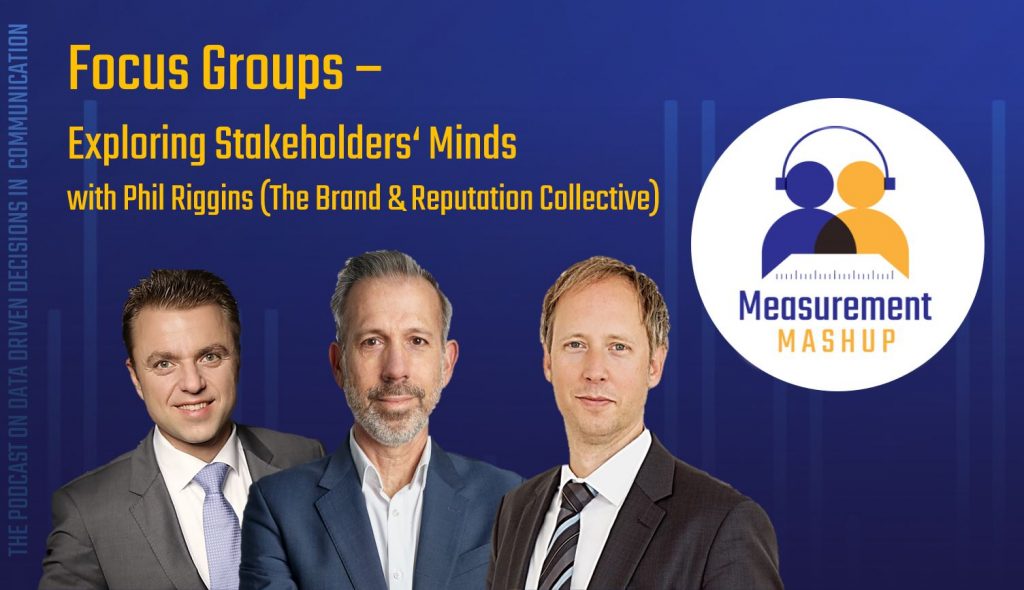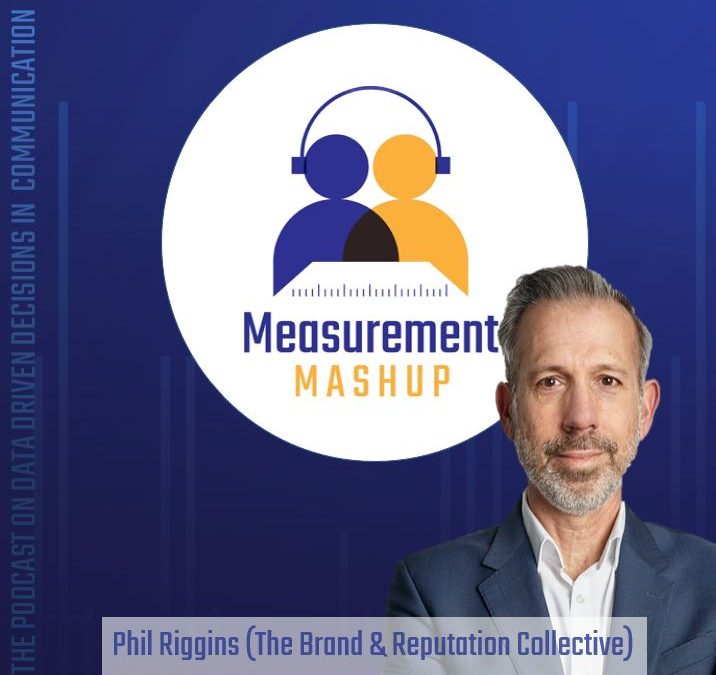The ultimate goal of communication is to achieve changes in perception or behavior of the target group. To evaluate these changes, there is no way around some kind of reading people’s minds. Most often companies use surveys, online or offline, on paper or as an interview. This episode is dedicated to focus groups – an alternative method to gain crucial insights.

Shownotes | About Phil Riggins| Submit a comment
Our guest is Phil Riggins, specialist in brand and reputation management and expert in the field of opinion research with 25 years of experience in building and leading teams in Europe, in the United States and on senior level for international agencies, such as Brunswick Group, Weber Shandwick and APCO Worldwide. Phil is founder of the Brand & Reputation Collective (BRC) and member of the European Association of Communication Directors (EACD) and the Market Research Society (MRS).
“[I am] a consultant who uses opinion research to give advice on how to tell a story. Basically, what I do is I help people tell their stories in a way that people can actually hear… always based on research.”
Phil Riggins
Focus groups are not very extensively used. They seem to have a reputation of being costly and labor intense. Moreover, keeping bias out of the gained insights can be a tricky task for the group’s moderator. In comparison to all the other measurement tools, for exsample interviews, surveys or digital analytics, focus groups are a method of qualitative research that is more about exploration and getting to know not only what people think, but why they think that way. How does that work? Focus groups consist of a small group of people and a moderator who might have a discussion guide who’s actual aim is to keep the conversation running in order to establish a range of opinions and feelings to a particular topic. The moderator might test the people’s reaction to ideas or content. Focus groups are open-ended and interactive and can take place just about everywhere.
“The way [focus groups] fit into the whole suite of tools depends on people’s approach, but I take a qual[itative-] quant[itative] approach.” Phil Riggins
Organisations can verify the qualitative results of the focus group discussion by running quantitative tests, to examine as to how common these views are in the population of interest. They might also do a quantitative subgroup analysis and find out that the opinion of e.g. a specific age group diverges from the general view. A focus group can then help answer the why. Using focus groups at the beginning of the process may come with surprising results, for example if consumers discuss a campaign idea before launch – and eviscerate it. [More details in the audio file: Phil Riggins talks about two cases in which focus groups helped marketing and communications to make a sound decision.]
How to select the right participants for a focus group?
It is important to understand who it is that matters to the success of your cause. Whose support do you need? Try to find a good mix, here. Keep in mind that some people can be encouraged to participate with a small monetary compensation. Others are motivated by the opportunity to network with people at their level.
How do you make focus groups work? How are they structured?
In order to make participants express what they really think, there are a couple of things you can do. One, a good moderator understands their own biases and checks them at the door.
Two, you have to create a space where people feel comfortable saying things that are uncomfortable or not politically correct or just feel kind of rude. You also want people to feel that they are part of a community. So shortly warm them up by asking a couple of innocuous questions about their daily activities, hobbies, interests etc. To balance the group out as a moderator, you will have to ask some people to be quieter and others to speak up and, thus, set the framework for this conversation.
You might have a guide with questions and themes that you need to work through, but don’t forget to keep it open-ended. You have to follow the strand of the conversation because that’s where the learnings come from. For insights, you have to listen for people saying something that comes unexpected, realize that that is interesting, pursue it and then check the room to see if other people have a similar view or different view, to get a sense of how interesting or relevant that is. You can come out with amazing insights that can turn things around for clients.
Keeping your own bias as a moderator out of the conversation can be hard when participants come up with rude or racist opinions. But you need to keep smiling, keeping the conversation open.
Is there an advantage in using internal moderation or is it better using external moderators?
If you have a well-trained moderator in the company, you might want to save money, but you’d miss on the benefits of an external moderator. The three main advantages of an external moderator are:
- Impartiality: He is not involved in the consequences of the insights that the focus group may come up with.
- Transparency: He can say things that are not politically correct in the organization
- Expertise: he brings in external expertise and a new point of view
Is it essential to be in one room all together to have these good insights or are online focus group an option?
Online focus groups are a huge plus in this time, people are comfortable with the technology, there are many platforms to choose from and you can combine them with workshop tools like Miro and Mural, so you can create interesting and powerful sessions. In normal focus group, there is a camera or people behind a one-way mirror. Participants are told in the beginning, but they forget quickly. Participants online might be a little inhibited because they are aware of being recorded all the time, but it is your task as a moderator to warm them up.
Online, there are synchronous groups, people logging in from anywhere around the world in real time. And there are also asynchronous groups where you post your questions and people respond when they want, over a week or two.
Is there a golden way to put together the participants?
It depends on the problem that you are trying to solve. Normally you would segment people in based around their demographics or their attitude about a particular question or their behaviours. If you segment your groups correctly you can end up with 12-20 groups and that gets really expensive. Clients often ask if one cannot just mix the people in the room and analyse the different attitudes later. You always look to balance between quality of the output and the available resources.
The insights are based just on a few voices. Are they representative?
If you are planning on an expensive all European campaign, you better validate the focus groups’ insights with quantitative research. On the other hand, experience proves that these results match really often. So these small groups seem to get a got grip of what our audience thinks. But you should always stress-test it a little bit.
How to convince your CEO to try focus groups?
Ask him how important the problem is, and how well he understands his audience and their view on the situation. There might be a disconnect between the company’s view and the view of the audience. Focus groups can gauge the degree to which those two views of reality are in alignment or disconnected and show the company how to close the gap.
Shownotes
Find Phil Riggins online
- on BRC, explaining how focus groups taught him that while “purpose” matters, without delivering what people pay you for, conversations about social purpose annoy rather than engage consumers.
- at the European Association of Communication Directors
- Market Research society
Mentioned collaboration tools:
Phil’s literature recommendations:
- James Harding: Alpha Dogs: How Spin Became a Global Business. A history of modern communications. It is fairly accurate but a wee bit biased against the industry. It shows how Weber Shandwick was built.
- Marty Neumeier: The Brand Flip. It explains about how brands are built these days and focuses on the concept of tribes and how smart brands know who their tribes are and play to them and not to every consumer.
About Phil Riggins
Phil Riggins is the founder of the Brand & Reputation Collective a consultancy that supports multinational companies as well as all types of organisations to understand and manage some of the world’s most well-known brands. Prior to creating the BRC, Phil worked at senior levels with the world’s leading communications agencies, including the Brunswick Group, Weber Shandwick, APCO Worldwide, and Leidar, advising clients on reputation as well as brand and issues management. He has worked across business sectors and around the world for organizations such as Airbus, Abbott Nutrition, The Bill & Melinda Gates Foundation, BT, The Coca-Cola Company, Danone, Diageo, eBay, GE, G4S, Google, Inditex, Itau, Kellogg’s, Nestle, Novartis, OPEC, Pfizer, Rexam, SAB Miller, Schroders, Smith & Nephew, the US Department of State, and Zurich. Phil is a dual national (US/UK) and started his career at the United States Information Agency, now part of the US Department of State, where he helped policy makers understand and manage one of the world’s most complicated brands – the United States of America. In addition, Phil is a member of various associations incl. the Market Research Society in the UK and the European Association of Communication Directors.

